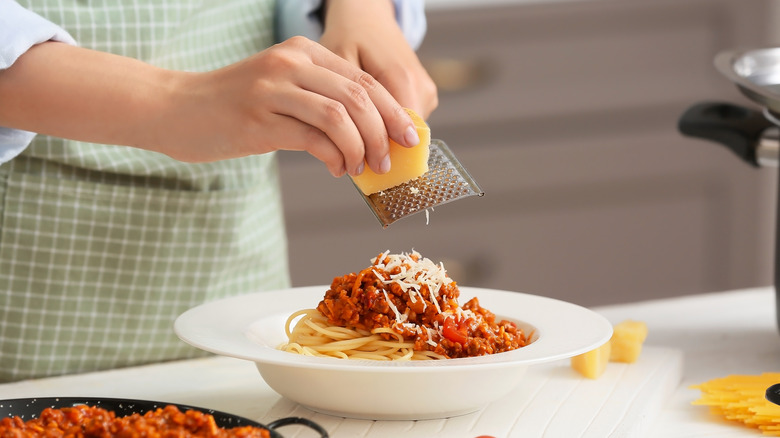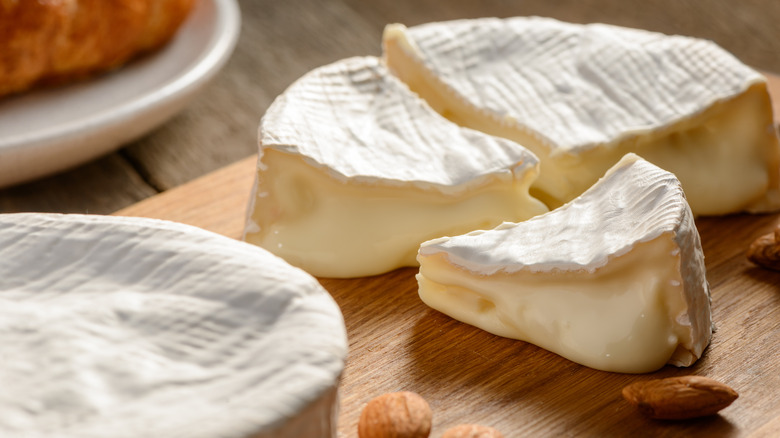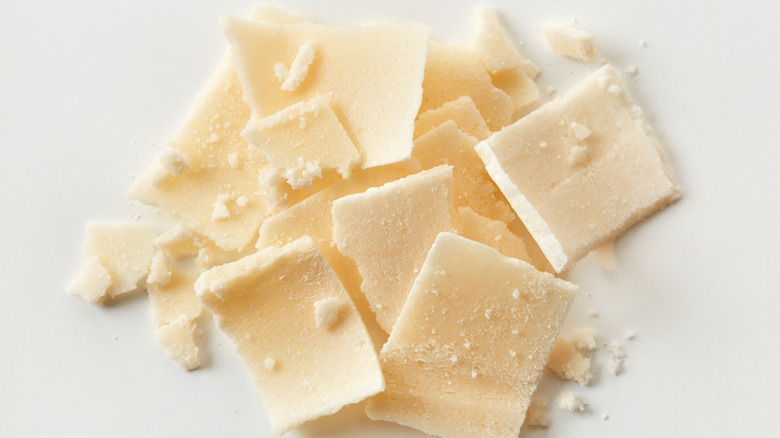The Way You Cut Your Cheese Is Vital To Preventing Clumps In Your Pasta
Cheese and pasta go together like, well, cheese and pasta. No matter what kind of delicious pasta you're having, whether it's homemade or at a restaurant, few of us will turn down a bit of freshly grated parmesan on top. And that's to not even mention the number of pasta recipes that call for cheese — most typically in sauce — well beyond that regular go-to.
But unless you're slicing your cheese the right way before it goes into or on top of your pasta, there is a very good chance that you aren't getting that rich, velvety texture that makes it such a perfect compliment to your linguine, your tortellini, your penne, rigatoni, or farfalle. Most of us know what this looks like, and what it feels like in the mouth: a lump of unmelted or semi-melted cheese in the middle of what otherwise might be a smooth, creamy bite.
This has to do with the science of how cheese melts. This isn't altogether unlike the way most solids become liquids, ice being the most obvious example. Generally, the more surface level is exposed, the quicker it will melt. Think of the way a spread-out pile of snow will melt more quickly than a firmly packed bucket of the stuff, then think of it as cheese, and you'll get the picture. Generally, the smaller and thinner the cheese, the quicker it will melt.
The type of cheese matters too
In other words, those of us looking for a shortcut by just dropping a big block of cheese into your sauce or into the pot of pasta will most likely wind up with those annoying lumps that sully the otherwise creamy texture. It's for this reason that we are so used to either thinly slicing or shaving our cheese onto our pasta or simply grating it.
Even this, however, may not be enough to ensure an even distribution or texture. How cheese melts isn't just down to the surface area. It's down to the specific arrangement of proteins, fats, and water in the variety of cheese, which affects how wet or dry it is, and how firm or creamy it might be. Generally, the more fat and water there is in a cheese, the weaker the protein structure.
Surprisingly, some of the cheeses most associated with pasta, including Parmigiano, are on the firmer side and tend therefore to have a higher melting point. "Most fresh cheeses such as fresco blanco, ricotta and cottage cheese, don't melt so much as liquefy, because they lack the protein structures to keep them cohesive," writes Kevin D. Weeks at NPR. "Most hard, dry cheeses, such as parmigiano and anejo, don't melt either (or at least they don't flow) because they lack the necessary liquid."
The denser the cheese, the thinner the slice
This kind of science helps explain why it is that one of the most recognized pasta cheeses tends to be grated or shaved so finely. Generally, it would seem that the denser and firmer the cheese, the smaller the slice or grate should be.
To be clear, there is no straightforward reason to limit one's choices to parmesan. With so many different types of cheese out there from all over the world, the possibilities, flavor, and texture combinations are virtually endless. There are many factors to consider when choosing the right cheese, but among them is the fact that different with different types of cheese will come with different melting points, and this therefore may change how you use it in pasta.
There are other factors to keep in mind. For starters, a single pile of even the most finely grated cheese will have trouble melting if it stays in one place. There's a good chance you've been there too: grated parmesan that isn't stirred around a bowl of pasta tends to clump up much in the same way it would if you just dropped a block of it into the pot. If you haven't served the pasta yet and are still cooking it, or if you are making a sauce, you will want to refrain from stirring in the grated or sliced cheese all at once. Rather, you should add it one handful at a time, making sure to thoroughly stir it.


